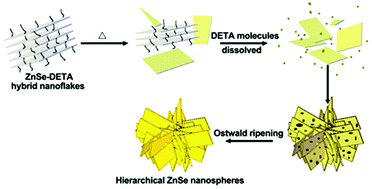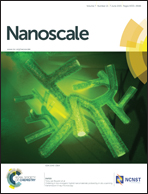Converting 2D inorganic–organic ZnSe–DETA hybrid nanosheets into 3D hierarchical nanosheet-based ZnSe microspheres with enhanced visible-light-driven photocatalytic performances†
Abstract
Engineering two-dimensional (2D) nanosheets into three-dimensional (3D) hierarchical structures is one of the great challenges in nanochemistry and materials science. We report a facile and simple chemical conversion route to fabricate 3D hierarchical nanosheet-based ZnSe microspheres by using 2D inorganic–organic hybrid ZnSe–DETA (DETA = diethylenetriamine) nanosheets as the starting precursors. The conversion mechanism involves the controlled depletion of the organic-component (DETA) from the hybrid precursors and the subsequent self-assembly of the remnant inorganic-component (ZnSe). The transformation reaction of ZnSe–DETA nanosheets is mainly influenced by the concentration of DETA in the reaction solution. We demonstrated that this organic-component depletion method could be extended to the synthesis of other hierarchical structures of metal sulfides. In addition, the obtained hierarchical nanosheet-based ZnSe microspheres exhibited outstanding performance in visible light photocatalytic degradation of methyl orange and were highly active for photocatalytic H2 production.


 Please wait while we load your content...
Please wait while we load your content...